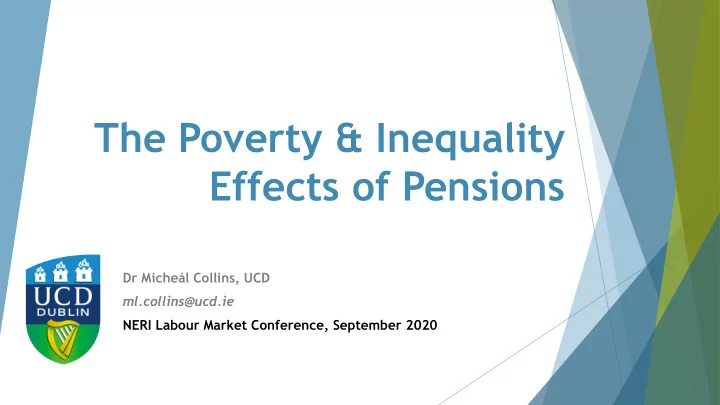

The Poverty & Inequality Effects of Pensions Dr Micheál Collins, UCD ml.collins@ucd.ie NERI Labour Market Conference, September 2020
Outline 1. Research Question 2. Why? 3. Data and Methods 4. Initial Results 5. Next Steps… 2
1. Research Question A core objective of pensions is poverty avoidance A core objective of redistribution is poverty avoidance Less direct focus on inequality effects implicit in poverty aims… Q: How effective are Ireland’s existing pension policy tools at reducing poverty and inequality? 3
1. Research Question A core objective of pensions is poverty avoidance A core objective of redistribution is poverty avoidance Less direct focus on inequality effects implicit in poverty aims… Q: How effective are Ireland’s existing pension policy tools at reducing poverty and inequality? 4
2. Why? An interest in the inequality effects of taxation measures interesting UK work from NSO… Broadened to other wing of redistribution: welfare effects within this state pensions expand to include private pensions… A pensions detour… 5
3. Data and Methods For this initial consideration: CSO SILC 2017 Microdata from the ISSDA at UCD 5,029 households and 12,612 individuals nationally representative, detailed income data, detailed socio- economic characteristics… linked to DEASP and Revenue sources to verify much of the income information Collins and Hughes (earlier years) showed robustness for pensions analysis 6
Pensions tools available to be examined: Work related pensions Private pensions (occupational and personal) State pensions occupational Social welfare pensions State pension social welfare OAP survivors pension 7
Inequality Decomposition Gini coefficient from 0 to 100 isolate stand-alone impact of each policy measure on the Gini Formally: Reynolds-Smolensky index Impact = Gini with – Gini without e.g. if Gini is 50 but increases to 55 if you remove the effect of redistribution by measure X, then the stand-alone effect of policy measure X is that it decreases the Gini by 5% 8
Poverty Decomposition Similar approach, looking with and without pension tool Using: Poverty risk = % of population below 60% median income poverty line (equivalised) Poverty gap = average distance below the poverty line Poverty count = number of people in poverty 9
4. Initial Results Initial… Baseline positions: results from SILC 2017 published report results with no pensions The simulations to identify effects 10
Table 1: The Poverty and Inequality Effect of Pensions, 2017 (ceteris paribus) Mean Poverty Gap € per Poverty Gini Poverty Count week Baseline 2017 SILC 15.7 31.5 755,592 56.35 Baseline no pensions 28.8 40.0 1,384,955 125.11
Table 1: The Poverty and Inequality Effect of Pensions, 2017 (ceteris paribus) Mean Poverty Gap € per Poverty Gini Poverty Count week Baseline 2017 SILC 15.7 31.5 755,592 56.35 Baseline no pensions 28.8 40.0 1,384,955 125.11 Simulations – results are changes to the no pensions baseline Pensions overall -13.1 -8.5 -629,363 -68.76
Table 1: The Poverty and Inequality Effect of Pensions, 2017 (ceteris paribus) Mean Poverty Gap € per Poverty Gini Poverty Count week Baseline 2017 SILC 15.7 31.5 755,592 56.35 Baseline no pensions 28.8 40.0 1,384,955 125.11 Simulations – results are changes to the no pensions baseline Pensions overall -13.1 -8.5 -629,363 -68.76 Work related pensions -3.5 -1.7 -164,437 -15.48
Table 1: The Poverty and Inequality Effect of Pensions, 2017 (ceteris paribus) Mean Poverty Gap € per Poverty Gini Poverty Count week Baseline 2017 SILC 15.7 31.5 755,592 56.35 Baseline no pensions 28.8 40.0 1,384,955 125.11 Simulations – results are changes to the no pensions baseline Pensions overall -13.1 -8.5 -629,363 -68.76 Work related pensions -3.5 -1.7 -164,437 -15.48 occupational state pensions -3.1 -1.6 -146,419 -14.73 private pensions -0.3 -0.1 -12,028 -0.76
Table 1: The Poverty and Inequality Effect of Pensions, 2017 (ceteris paribus) Mean Poverty Gap € per Poverty Gini Poverty Count week Baseline 2017 SILC 15.7 31.5 755,592 56.35 Baseline no pensions 28.8 40.0 1,384,955 125.11 Simulations – results are changes to the no pensions baseline Pensions overall -13.1 -8.5 -629,363 -68.76 Work related pensions -3.5 -1.7 -164,437 -15.48 occupational state pensions -3.1 -1.6 -146,419 -14.73 private pensions -0.3 -0.1 -12,028 -0.76 Social Welfare pensions -9.1 -5.0 -435,255 -43.44
Table 1: The Poverty and Inequality Effect of Pensions, 2017 (ceteris paribus) Mean Poverty Gap € per Poverty Gini Poverty Count week Baseline 2017 SILC 15.7 31.5 755,592 56.35 Baseline no pensions 28.8 40.0 1,384,955 125.11 Simulations – results are changes to the no pensions baseline Pensions overall -13.1 -8.5 -629,363 -68.76 Work related pensions -3.5 -1.7 -164,437 -15.48 occupational state pensions -3.1 -1.6 -146,419 -14.73 private pensions -0.3 -0.1 -12,028 -0.76 Social Welfare pensions -9.1 -5.0 -435,255 -43.44 old age pensions (cash) -8.8 -4.8 -420,648 -42.11 survivors benefit (cash) -0.3 -0.2 -14,607 -1.33
5. Next Steps Suggestions? Plan for: multiple years of SILC (to establish the average effect, although will do detailed analysis on just one year) will add 2018 data (new!) split poverty indicators to examine above and below 65yrs / 70yrs gender differences A later in 2020 project… 17
The Poverty & Inequality Effects of Pensions Dr Micheál Collins, UCD ml.collins@ucd.ie NERI Labour Market Conference, September 2020
Recommend
More recommend